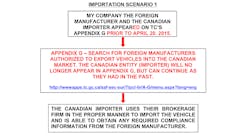Industry consolidation is nothing new in various markets, including the automotive sector. In the last year or so, there have even been headlines about trucking industry mergers and acquisitions (M&A). In fact, some headlines suggest that the increased pace of these deals is positive for the sector. In a way, that may be true when you look at the freight hauling side of the business that is highly fragmented. However, the end result is undoubtedly higher shipping rates for consumers as M&A’s buy up existing capacity. Likewise M&A’s do not result in the purchase new trucks and trailers.
Not to worry, trailer production is holding strong and is projected to remain steady through 2015, according to industry economists. Demand remains steady and this is good for trailer dealers and manufacturers alike. Backlogs are up and this is causing some headaches for fleets as well as dealers. Still, overall, business is good right now. However, it is important to keep an eye on what is happening with other market segments and what it could mean for the trailer industry down the road.
There are an abundance of challenges from one year to the next for carriers from driver shortages to ever-increasing regulations. In 2013, M&A’s among carriers were up 57% over 2012, according to PricewaterhouseCoopers. Many of the M&A’s have focused on companies with niche or regional markets and established customer bases with an opportunity to expand their service offering to existing customers, according to Go by Truck magazine.
As fleets look for efficiency and growth through consolidation, they are increasing their buying power. At the same time OEMs have to meet ever-increasing more stringent fuel economy standards, and control product quality and consistency — all while trying to meet customer price demands. One way manufacturers may do that is to streamline their dealer networks. In the truck market segment for example, Freightliner has reduced its dealer network from 1,200 to 200.
If OEMs look to consolidate their trailer dealer networks in the future, perhaps it is worth looking at what dealers should consider now while sales are strong. First, don’t wait until the economy turns down again to do something about things that need fine tuning in your operation. If you know that there are issues within your parts and service department, fix them while you have the resources. Hire a consultant or take steps necessary to ramp up productivity and efficiency through better hiring, training, or process improvements.
Second, the trailer industry always seems to lag behind other industries when it comes to technology. The fleets are smarter, more sophisticated, technologically savvy customers with greater demands and more buying power. OEMs have a product to sell with or without the support of their dealer network. The OEMs are in a position to pick and choose which dealers they want in their network as evidenced by the aforementioned truck market dealer streamlining. Now is the time to make an investment in an inventory management systems, online ordering capabilities, ensure you have access to your OEM’s enterprise network(s) and provide technician as well as office systems training for their dealership staff. If you are a dealer that purchased an inventory management system or new accounting package four years ago but never implemented it, now is the time to bite the bullet and embrace change throughout your dealership. As painful and disruptive as some changes may be in the short-term, think about the bigger picture and what you need for long-term success.
I have heard estimates that 75%–80% of trailer dealerships in the U.S. do not utilize major business systems software for inventory management. The days of pen and paper management should be a thing of the past, but that is how a lot of dealerships still operate today. Bar coding, RFID and other types of inventory control technology have been around for years, but few dealerships utilize these forms of automation.
In today’s fast-paced world of smart phones, tablets and cloud computing, fleet customers demand information at the touch of a button and so do the OEMs. That level of instantaneous interaction, communication and reporting is not only vital to efficiency and productivity, it is simply expected.
Along those same lines, the average age of managers and dealer principals that attend National Trailer Dealers Association programs and events is around 55. What are you doing to prepare your dealership for the next generation? Is your dealership training and developing its employees for growth and movement within the organization and preparing a strategic plan that includes succession planning? Does your organization embrace ideas from up and coming employees who are knowledgeable about technology or other important ways to breathe new life into the business? The world and the trailer industry are changing. How dealers and manufacturers alike choose to streamline, education, promote, modernize and run their businesses will ultimately determine the long-term industry players when the economy takes its next downturn.




